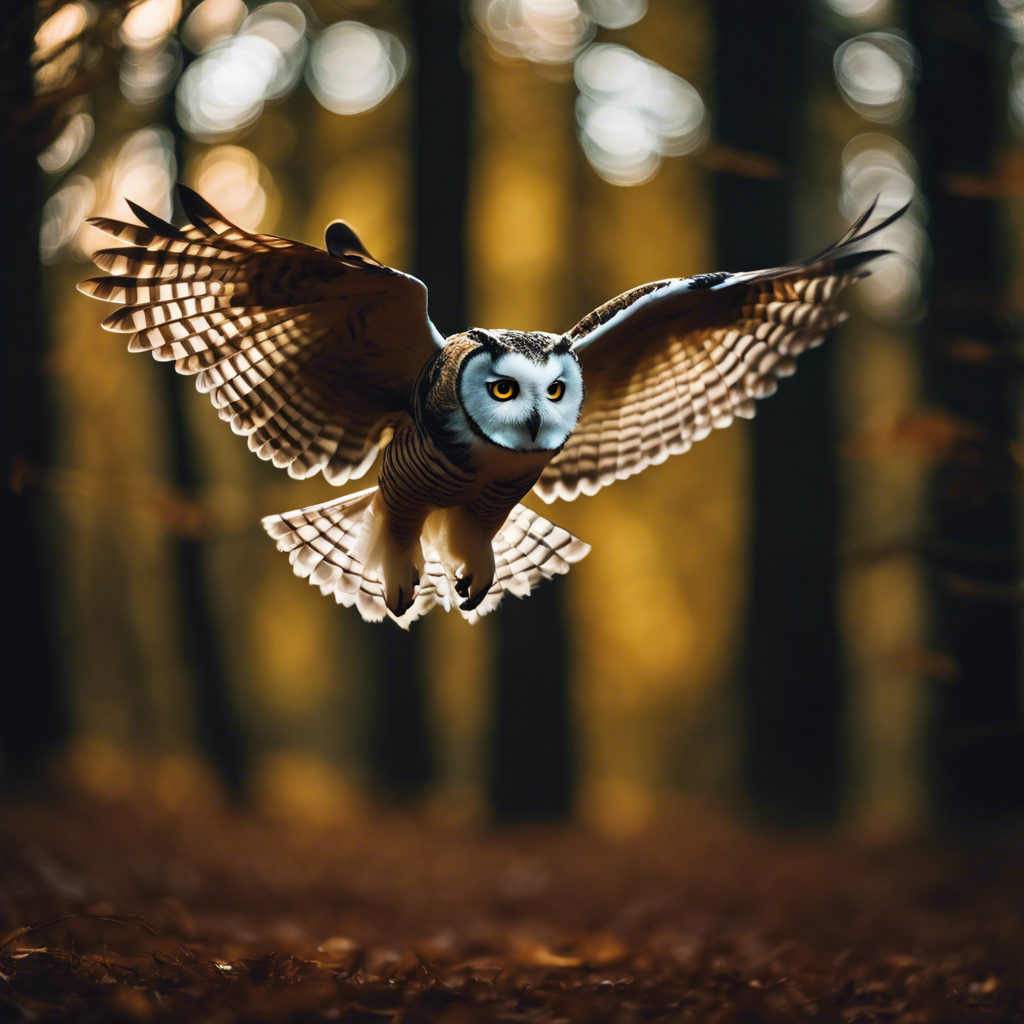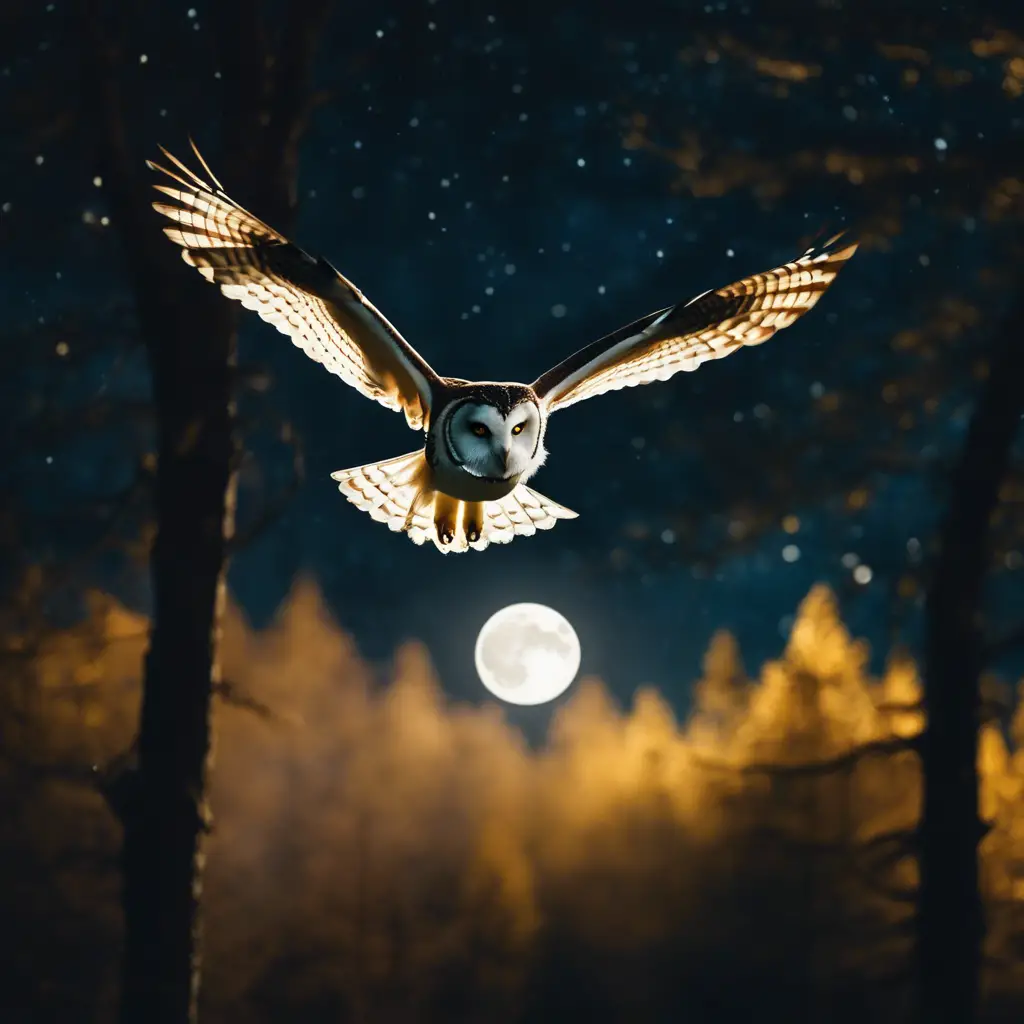In my experience as an ornithologist, I’ve spent countless nights under the stars, marveling at owls in flight. I believe their nocturnal prowess is as enchanting as it is critical for survival.
Once, as I observed through my binoculars, a barn owl glided silently over a moonlit field—a testament to evolutionary perfection. My expertise has taught me to appreciate the nuances of their behavior; not all owls are strictly night hunters.
Each encounter deepens my connection with these mysterious creatures and the shadowy world they navigate so effortlessly.
Key Takeaways
- Owls have evolved extraordinary nocturnal abilities, allowing them to navigate the darkness with precision and silence.
- Owl vision in nighttime conditions is enhanced by the tapetum lucidum layer and an abundance of rod cells, giving them acute sensitivity to minimal light sources.
- The unique structure of owl feathers enables near-silent flight, and their asymmetrical ears assist in pinpointing the location of sounds.
- Owl species’ nighttime activity is vital for maintaining ecological balance, as they control populations of nocturnal insects and rodents.
Unveiling Owl Nocturnal Behavior
Owls have evolved extraordinary nocturnal abilities, allowing them to navigate the darkness with remarkable precision and silence in pursuit of prey. As nocturnal birds, they’re uniquely attuned to the night, when their keen senses enable them to see and hunt efficiently.
Their large, forward-facing eyes absorb more light, enhancing their ability to see well in low-light conditions. The asymmetry of their skulls and the arrangement of their ears allow for precise auditory triangulation, pinpointing prey with little to no visual cues.
Their silent flight is attributed to specialized feather structures that muffle the sound of air passing over their wings, giving them a stealth advantage.
Such adaptations not only facilitate their active at night lifestyle but also bolster their survival, as they can effectively evade predators and exploit a nocturnal niche.
Owl Vision in Nighttime Conditions

Harnessing the power of their large, binocular eyes, owls excel in low-light hunting by utilizing a tapetum lucidum layer and an abundance of rod cells to navigate the darkness with remarkable efficiency. Different types of owl species have evolved large eyes that enable them to see prey and obstacles even under the veil of night.
These adaptations are crucial, as owl vision in nighttime conditions demands acute sensitivity to minimal light sources. The tapetum lucidum, a reflective layer behind the retina, effectively doubles the intensity of incoming light, significantly improving an owl’s night vision.
This, coupled with a high concentration of rod cells, which are more sensitive to light than cone cells, allows owls to detect even subtle movements, ensuring their prowess as nocturnal predators.
The Acoustics of Owl Flight
While their exceptional night vision allows owls to track prey in the dark, it’s the unique structure of their feathers that affords them near-silent flight, a critical factor in their nocturnal hunting success. Unlike birds that are active during the day, owls become active at night, when silence is paramount.
Their feather design is specialized: the edges are serrated, disrupting airflow and reducing sound. This acoustical adaptation enables owls to fly almost noiselessly. Barn owls, for example, demonstrate this silent efficiency exceptionally well.
Furthermore, the asymmetrical placement of an owl’s ears assists in pinpointing the precise location of sounds, complementing their stealthy approach. Thus, the acoustics of owl flight are finely tuned to ensure successful predation under the cover of darkness.
Owl Species and Nighttime Activity
Diving into the nocturnal world, you’ll find various owl species adeptly navigating the darkness, their evolutionary traits fine-tuned for nighttime activity. These birds, with large forward-facing eyes, possess exceptional night vision, a crucial adaptation that facilitates their ability to fly at night. Consider the great horned owl, a prime example of an avian predator whose feathers are specialized for silent flight, enabling it to hunt for food undetected.
Owl species exhibit a wide range of behaviors, but their nocturnal habits are particularly vital for maintaining ecological balance by controlling populations of nocturnal insects and rodents. Although some have adapted to daylight, seeing an owl engaged in nighttime activity remains a common and remarkable aspect of their existence.
Frequently Asked Questions
Are Owls the Only Birds That Fly at Night?
You’re mistaken if you think owls are the only nocturnal fliers. Nightjars and kiwis also thrive after dark, utilizing acute hearing and vision to hunt, all while maintaining crucial insect population balance.
What Time of Night Do Owls Come Out?
You’ll typically observe owls emerging at dusk, though their activity peaks vary among species and are influenced by individual behaviors and the surrounding environment’s conditions.
Do All Owls Fly Silently at Night?
You might wonder if all owls fly silently at night. While most do, due to feather adaptations, not every species has the same level of soundless flight, varying with their hunting strategies.
What Does an Owl Look Like in Flight?
You’ll observe an owl’s silent, stealthy flight characterized by serrated wing feathers and a large wingspan, with their head turning remarkably, showcasing agility and superior night vision with forward-facing eyes.
Conclusion
You’ve uncovered the nocturnal world of owls, noting their remarkable night vision and silent flight. Their specialized feathers cut through the air with minimal noise, a stealthy adaptation for hunting.
Diverse owl species exhibit varying degrees of nighttime activity, yet their shared adaptations for the dark demonstrate evolution’s fine-tuning for survival. Your exploration of these raptors reveals the intricate balance between sensory capabilities and predatory efficiency in the still of the night.

An avid ornithologist, zoologist and biologist with an unwavering passion for birds and wild animals.
Dr. Wilson’s journey in ornithology began in childhood and led him to obtain a Ph.D. in Ornithology from the prestigious Avian Research Institute. He has worked closely with renowned experts in the field and conducted extensive research and field studies globally.

